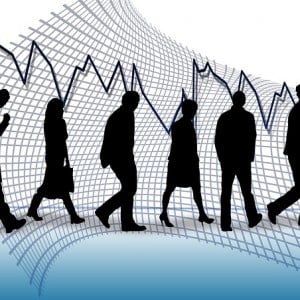The Gig Economy: Which Side Are You On?

The tall good looking New Yorker, about 25, stands out in the crowd around me. His black curly hair shines, his head raised expectantly, his smile so unlike the people around us peering anxiously into their handheld devices.
I’ll learn before my trip ends that this warm faced lad’s name is Dijon.
Our fleeting association begins there on the platform waiting for the uptown #6 train. Initially his smile attracts me; then my gaze rises beyond his face to a shimmering red and silver flag; it’s actually a balloon waving above us, and I know this belongs to Dijon. Seeing “Happy Anniversary” scrolled clearly on the shimmering surface, I think ‘He’s returning from an office party celebrating his marriage’. That would explain his smile too.
I’m distracted by a growl from the mouth of the tunnel, a welcome noise to commuters at the end of their workday. Here comes the #6 train. The platform, dense with thick-coated bodies, begins to stir, prepared to press into the cars. Forget about a seat; I may not even find standing room. At 4:30 p.m., the rush of workers heading uptown to their homes—one room, maybe two, three at the most, somewhere in the Upper East Side, Spanish Harlem or the Bronx– has begun.
I am unconcerned how Dijon, with his unwieldy balloon and the large carton cradled in his arms, manages to maneuver himself into the train as thirty other commuters lurch through that single door. Then, doors safely closed behind us, I see that same balloon. And, there beside me, our backs similarly pressed against the door, stands its bearer with the same quiet smile.
As this isn’t my regular route, I must check on where I should disembark and, of course, I look up towards the anniversary flag:
“Does the #6 stop at 84th street?”
His voice is soft and reassuring:
“We stop at 86th— good for you. But you know you could have taken the #5 express across the platform; you’d reach in just two strops by the five.”
Never mind; with this friendly opener I proceed with my inevitable interview, probing my travel companion’s agenda and introducing me to another New York lifestyle experience.
“Your anniversary?” I inquire. “How many years?”
“Oh no”, Dijon quickly rejoins, glancing at the balloon above us: “I’m delivering this: Edible Arrangements. We’re a party service (I’ll Google it later.)”
Nodding to the package in his arms now, he explains this service for family celebrations;
“They get the balloon and our fruit package — chunks of fresh pineapple, melon, apple, stuff like that– arranged on sticks all poking out of a big orange. It’s really pretty, done up like a bouquet.”
And do you sing as you present this gift?
“No, no”, and pausing, adds “But I could sing”.
It occurs to me that Dijon may in fact be a talented vocalist– a singer, an actor, a performer of some kind. He’s probably one of the tens of thousands of gifted young people drawn to the city in search of gigs on stage, hunting for an agent, waiting to be discovered. Yes, that explains his bearing. I miss that cue, and instead ask about his ‘edible’ services; it’s a lifestyle service, the pampering of well-to-dos and trend-obsessed young people who socialize with indulgences, like hand delivered balloons and fruit baskets.
“For say $50?”, I guess.
“Hmm”, replies Dijon; “$50 and up.”
I think: what could he earn for one delivery (remembering he has to travel by subway)? Maybe $10. I can’t ask him directly, but I manage
“And tips? Do your happy anniversaries tip well?” Another “Hmmm” from Dijon.
“No tips: not usually.”
(No point inquiring about health insurance or workman’s compensation.)
These delivery gigs today employ battalions of young and energetic do-anything-to-live-in-New Yorkers. Would-be actors, comedians and musicians traditionally wait tables and serve drinks in the city’s many bars. But those jobs are now augmented by these delivery services which employ jobless graduates and anyone else willing to serve those who can pay, however indulging and frivolous the service. What’s offered are sometimes routine and tedious (house-cleaning, dog walking), at other times exotic and terribly fashionable (you can’t imagine).
Subway advertisements abound with invitations to do something special for yourself, or a loved one—all by phone apps, and like Uber– delivered personally by a young man or woman at your door. Handy.com, delivery.com, taskrabbit, upwork.com, blueapron.com, redbucket.com, deliveroo.com are just a few examples of what’s available.
It’s the gig economy; on one hand it’s emerging from excessive joblessness, a serious condition finally receiving attention from workers rights advocates t5. On the other hand it’s created by people with abundant disposable incomes. It’s based on both desperation and trendyness. Servitude is a growth industry in American cities. Edible arrangements.com and bueapron.com are New York chic.
The fashion crowd—i.e. those with monthly salaries, health insurance, social security savings and a company pension fund— chat in the bar or at office break about these trendy services, similar, one imagines, to how white ladies chatted about their domestic ‘help’.
The Sunday Lifestyle section of your newspaper features the merits of blueapron.com fashion. Meanwhile less noticed reviews expose the inbuilt exploitation and the hardships lived by these young workers.
Doubtless some of the tens of thousands of wishful, handsome jobless graduates, come away from their glimpses inside those wealthy apartments to whom they delivered massages and fruit bouquets, gather after hours to invent their own startup service. Maybe they themselves can launch the next trend.
No one is thinking about workers rights. In fact a new adjunct trend is umbrella recruitment companies. They locate, vet and sign up individuals who they then farm out for hour and day jobs. In the UK this service extends to school teachers—all to save someone else money.

